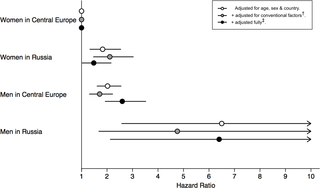PLOS Medicine ( IF 10.5 ) Pub Date : 2017-12-06 , DOI: 10.1371/journal.pmed.1002459 Taavi Tillmann 1 , Hynek Pikhart 1 , Anne Peasey 1 , Ruzena Kubinova 2 , Andrzej Pajak 3 , Abdonas Tamosiunas 4 , Sofia Malyutina 5, 6 , Andrew Steptoe 1 , Mika Kivimäki 1 , Michael Marmot 1 , Martin Bobak 1

|
Background
Eastern European countries have some of the highest rates of cardiovascular disease (CVD) mortality, much of which cannot be adequately accounted for by conventional CVD risk factors. Psychosocial and socioeconomic factors may affect risk of CVD, but relatively few studies on this issue have been undertaken in Eastern Europe. We investigated whether various psychosocial factors are associated with CVD mortality independently from each other and whether they can help explain differences in CVD mortality between Eastern European populations.
Methods
Participants were from the Health, Alcohol and Psychological factors in Eastern Europe (HAPIEE) cohort study in Russia, Poland and the Czech Republic, including a total of 20,867 men and women aged 43–74 years and free of CVD at baseline examination during 2002–2005. Participants were followed-up for CVD mortality after linkage to national mortality registries for a median of 7.2 years.
Results
During the follow-up, 556 participants died from CVD. After mutual adjustment, six psychosocial and socioeconomic factors were associated with increased risk of CVD death: unemployment, low material amenities, depression, being single, infrequent contacts with friends or relatives. The hazard ratios [HRs] for these six factors ranged between 1.26 [95% confidence interval 1.14–1.40] and 1.81 [95% confidence interval 1.24–2.64], fully adjusted for each other, and conventional cardiovascular risk factors. Population-attributable fractions ranged from 8% [4%–13%] to 22% [11%–31%] for each factor, when measured on average across the three cohorts. However, the prevalence of psychosocial and socioeconomic risk factors and their HRs were similar between the three countries. Altogether, these factors could not explain why participants from Russia had higher CVD mortality when compared to participants from Poland/Czech Republic. Limitations of this study include measurement error that could lead to residual confounding; and the possibilities for reverse causation and/or unmeasured confounding from observational studies to lead to associations that are not causal in nature.
Conclusions
Six psychosocial and socioeconomic factors were associated with cardiovascular mortality, independent of each other. Differences in mortality between cohorts from Russia versus Poland or Check Republic remained unexplained.
中文翻译:

东欧心血管死亡率的心理社会和社会经济决定因素:一项多中心前瞻性队列研究
背景
东欧国家有一些心血管疾病 (CVD) 死亡率最高的国家,其中大部分无法用传统的 CVD 风险因素充分解释。心理社会和社会经济因素可能会影响心血管疾病的风险,但在东欧开展的关于此问题的研究相对较少。我们调查了各种心理社会因素是否与 CVD 死亡率相互独立相关,以及它们是否有助于解释东欧人群之间 CVD 死亡率的差异。
方法
参与者来自俄罗斯、波兰和捷克共和国的东欧健康、酒精和心理因素 (HAPIEE) 队列研究,包括 20,867 名年龄在 43-74 岁之间且在 2002 年基线检查时未发现 CVD 的男性和女性—— 2005 年。在与国家死亡率登记处联系后,参与者的 CVD 死亡率随访中位数为 7.2 年。
结果
在随访期间,556 名参与者死于心血管疾病。相互调整后,六个社会心理和社会经济因素与心血管疾病死亡风险增加相关:失业、物质条件差、抑郁、单身、不经常与朋友或亲戚接触。这六个因素的风险比 [HRs] 介于 1.26 [95% 置信区间 1.14-1.40] 和 1.81 [95% 置信区间 1.24-2.64] 之间,相互完全调整,以及传统的心血管危险因素。当对三个队列进行平均测量时,每个因素的人口归因分数范围从 8% [4%–13%] 到 22% [11%–31%]。然而,这三个国家的心理社会和社会经济风险因素及其 HR 的患病率相似。共,这些因素无法解释为什么与波兰/捷克共和国的参与者相比,来自俄罗斯的参与者的心血管疾病死亡率更高。本研究的局限性包括可能导致残余混杂的测量误差;以及来自观察性研究的反向因果关系和/或不可测量的混杂导致本质上不是因果关系的可能性。
结论
六个心理社会和社会经济因素与心血管死亡率相关,彼此独立。来自俄罗斯与波兰或检查共和国的队列之间的死亡率差异仍然无法解释。










































 京公网安备 11010802027423号
京公网安备 11010802027423号